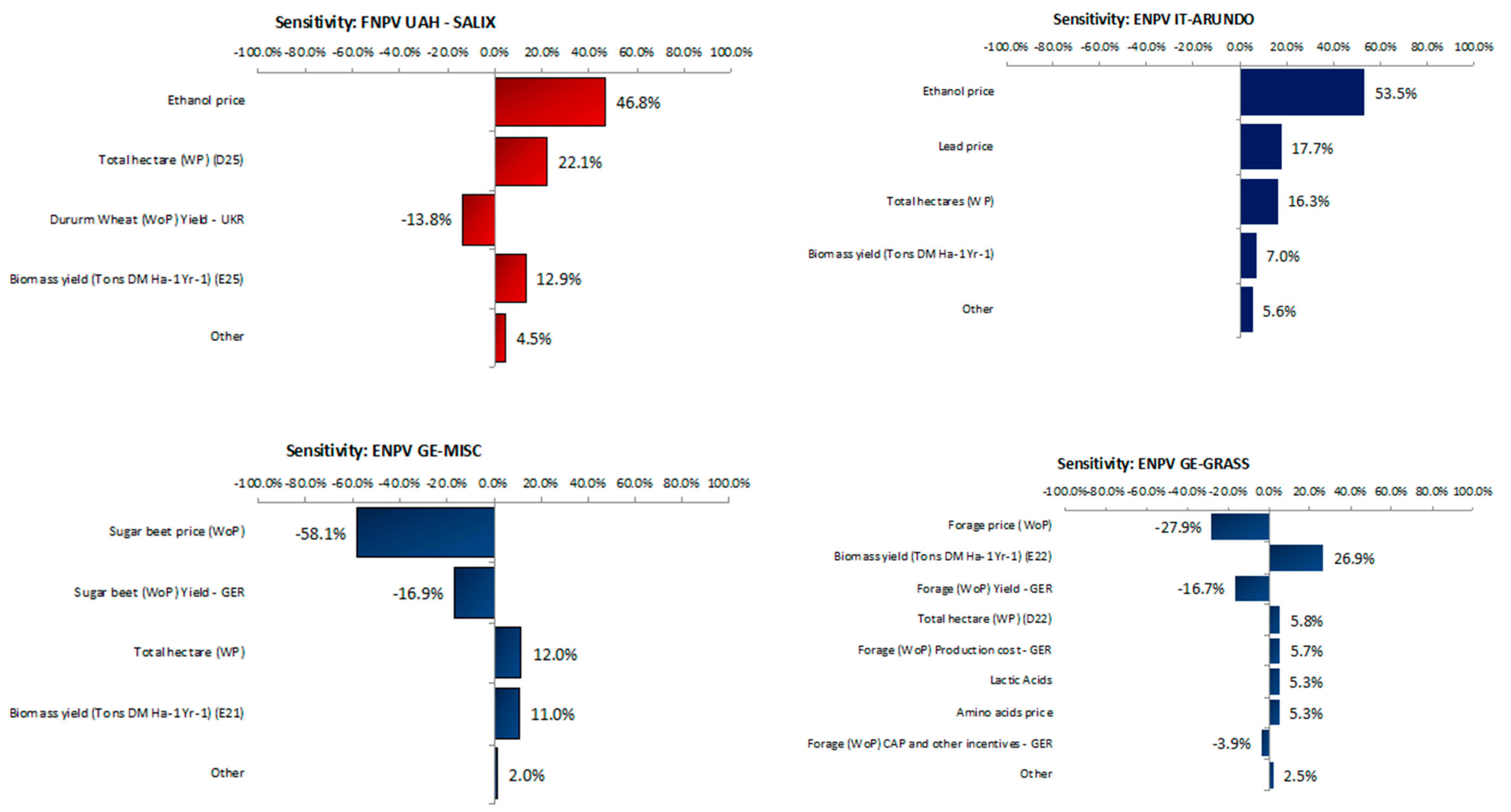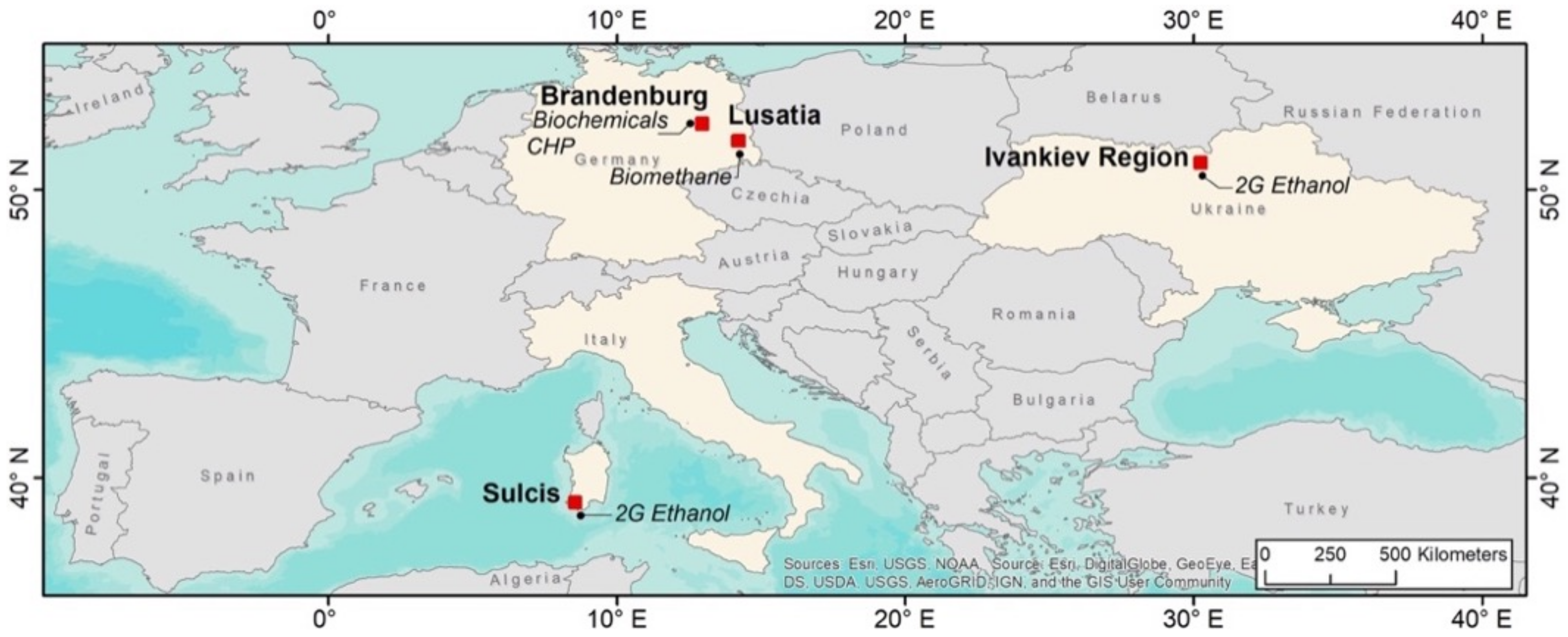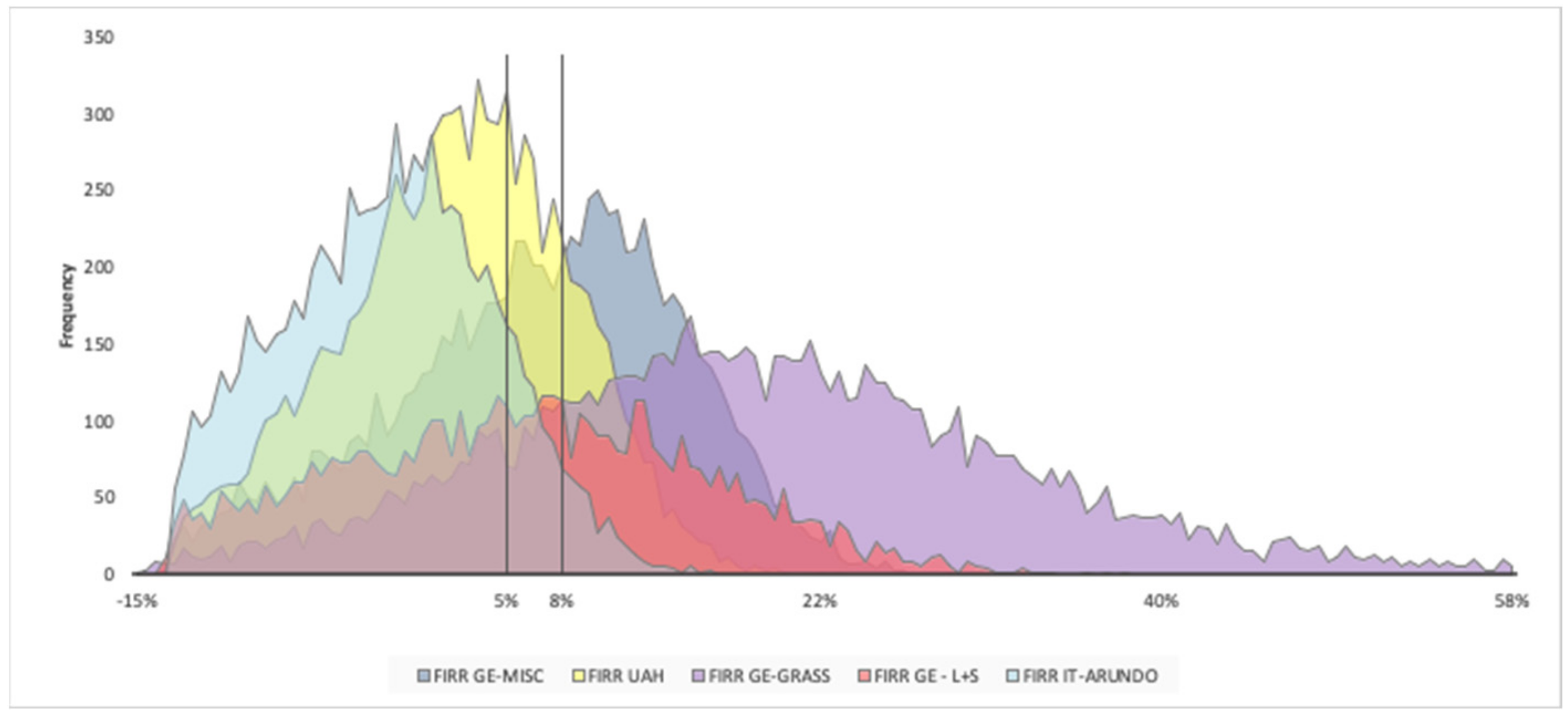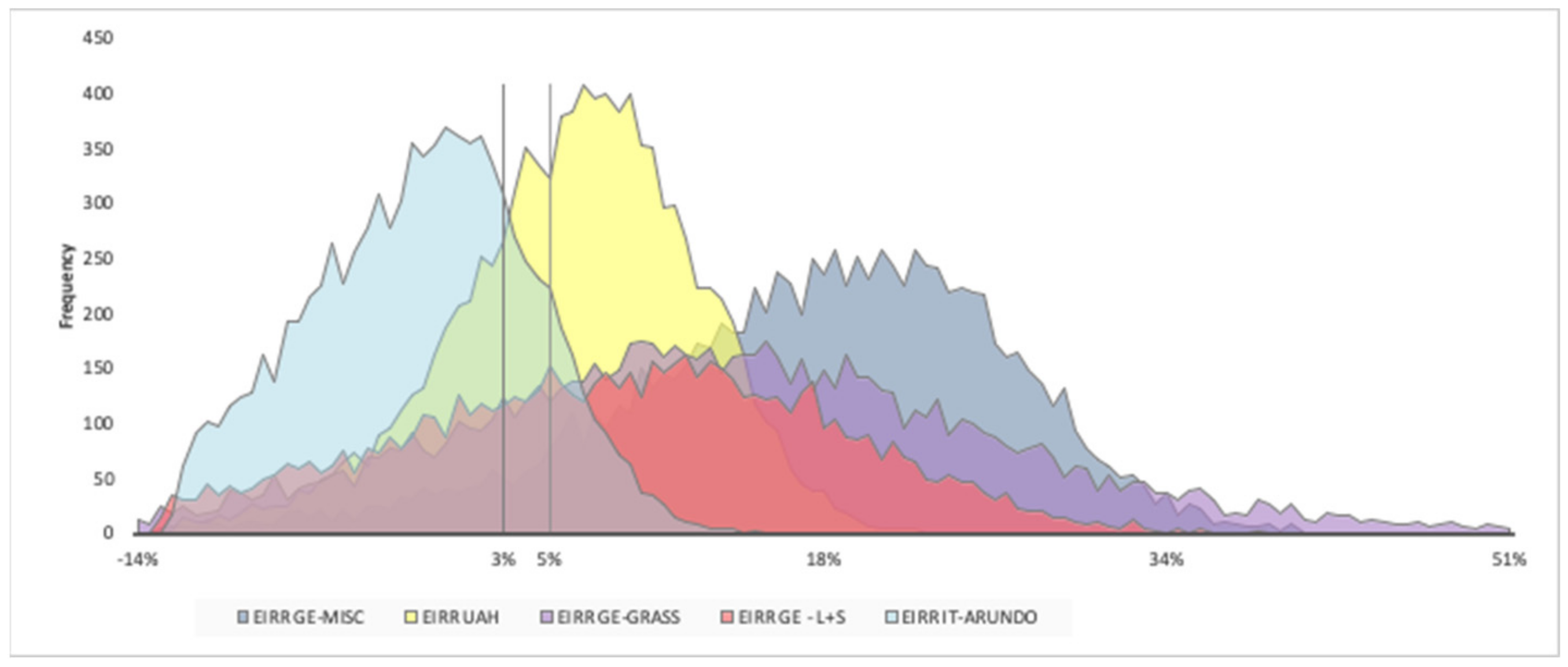2.1. Case Study Sites
The reference countries for this analysis are Italy, Germany and Ukraine. The areas considered by this study are as follows: (i) the Sulcis area in the south-western part of the island of Sardinia, Italy (a known Site of National Interest due to the presence of contaminants in the soils, particularly heavy metals); (ii) two study areas located in Brandenburg, north-eastern part of Germany (the former sewage irrigation fields near the city of Berlin and the lignite reclamation sites in Lusatia); (iii) the Ivankiv Region of Ukraine (specifically the non-exclusion zone just south of the Chernobyl disaster area). The countries were selected in the context of the FORBIO project as examples of countries with a bioenergy production potential allowed by the large amount of available MUC land. Furthermore, the three countries were also selected based on their different income level: Ukraine is a lower-middle income country, and Germany and Italy are high-income countries. This allowed to compare both EU and non-EU neighboring countries with different economies and regulations.
Table 1 and
Table 2 describe the crops and bioenergy pathways considered for this study, whilst
Figure 1 shows a map of the potential bioenergy case study sites; total hectares considered for the investments are presented in
Table 3.
As shown in
Table 1, in Italy, the case study (CS) site was the contaminated land in Carbonia in the Sulcis area, where the land has been affected by chemical contamination, and therefore, all agricultural activities are banned by both local and National Government (although some illegal agriculture and pasture use occurs) [
17,
18]. Irrigated Giant reed was considered for the production of 2G ethanol and electricity as co-product with an average yield of 25 tons ha
−1 yr
−1 of dry matter (DM). Around 7200 ha were considered to feed a hypothetical biorefinery with capacity of 40,000 tonnes.
In Germany, the identified potential for the cultivation of
Miscanthus x giganteus on the former sewage irrigation fields in the surroundings of Berlin was 1140 ha [
19,
20]. According to Mergner et al. [
20], miscanthus has the potential to remediate the contamination of heavy metal in soils and possibly render this land suitable for food production. According to Pogrzeba et al. [
21], miscanthus grown on contaminated soils can accumulate up to 5 mg Cd kg
−1, 150 mg Pb kg
−1 in its biomass, as well as 700 mg Zn kg
−1, making it a promising crop for phytoremediation. The considered yield for miscanthus production was 15 tons ha
−1 yr
−1 of DM. Miscanthus production was considered for combined heat and power (CHP) production from combustion.
The cultivation of spontaneous grasslands on the former sewage irrigation fields in the surroundings of Berlin was also analysed. Nowadays in Germany, grassland is mainly used for cattle farming; however, during the last decades, notable changes in grassland use can be noted [
20]. According to Thumm et al. [
22], there are new options to use grassland biomass for energy purposes as well as for biobased products. Based on Knoche at al. [
19], the identified potential for the cultivation of grasslands was approximately 1140 ha, while the potential yield of grass was identified to be around 3 tonnes per ha per year of DM.
Post-mining reclamation sites in Germany were also assessed. According to Mergner et al. [
20], the identified potential for the cultivation of Lucerne and Sorghum was approximately 7295 ha. The considered yields for Sorghum and Lucerne selected for the production of biomethane would be 5 and 10 tonnes DM ha
−1 yr
−1, respectively.
For the Chernobyl non-exclusion zone in the Ivankiv Region in the Ukraine, the identified potential for the cultivation of Salix was 16,720 ha, with an identified yield of around 10 tonnes DM ha
−1 yr
−1 [
23]. As for the Italian case study site, in Ukraine, Salix biomass was considered for 2G ethanol production.
Table 2 shows the yield and the production cost of the bioenergy crops considered for the analysis. Potential production in tonnes per year is estimated considering the total hectares identified in each case study site. Furthermore, although the biomass produced is not sold to the market, national market prices of feedstock and potential income at farm gate are provided to show the possible income obtainable by farmers from the sale of the biomass.
2.2. Financial Analysis
A financial analysis was carried out, where a standard cost benefit analysis (CBA) approach was applied to demonstrate net profits. This analysis was included to compute the investment’s financial performance indicators [
24] and was carried out in order to:
Assess the consolidated investment’s profitability, With Project (WP) vs Without Project (WoP) scenarios;
Assess the profitability for the investor(s);
Outline the cash flows which support the calculation of the socio-economic costs and benefits.
Following the CBA framework defined by the European Commission [
22], impact categories were identified and associated with the alternative scenario (with project scenario) where biofuels are produced in the countries. The impact outside the countries’ borders was not considered (e.g., no global market distortion). Reference values, conversion factors, prices and other relevant information considered for the analysis are presented in
Table A1,
Table A2,
Table A3 and
Table A4. Particularly, prices for the financial analysis are presented in
Table A4.
Annual financial net benefits of producing biofuels are given by:
where:
b: corresponds to the bioenergy pathways (e.g., 2G ethanol from Giant reed (Arundo donax) in Italy, biomethane from spontaneous grass and cultivated Alfalfa (Alpha-alfae) in Germany, and 2G ethanol from Willow (Salix viminalis) in Ukraine)
πb(Qi): annual net benefits of the biofuel pathway i
Pb: the price of biofuels as final product in the market
w: unit wages
Lb: quantity of labour force (salary)
f: unit price of feedstock
Fb: amount of feedstock used to extract per unit biofuel
n: per unit cost of chemical
Nb: related chemicals such as sulphuric acid, methanol etc. (inputs)
e: the price of utilities, e.g., electricity, biogas and coal
Ub: amount of utilities, e.g., electricity, biogas and/or coal (inputs and Miscellaneous)
m: the market price of by-products
Mb: amount of by-products produced during conversion process
The cost and benefits listed above were obtained in an aggregated form from [
15,
16]. These data were directly provided by industrial bioenergy processors (e.g., Biochemtex) to FAO. This was mainly due to the difficult availability of detailed information about processing costs and technologies for modern or 2G biofuels and biochemicals biorefineries (e.g., 2G ethanol or lactic acid plants). Furthermore, for consistency, the same aggregation was applied to the analysis of non-modern bioenergy such as CHP.
Following the method described by the Guide to cost-benefit analysis of investment project of the European Commission [
24] and [
25], determination of investment revenues and expenditures enables the assessment of the project profitability, which is measured by financial net present value (FNPV) and financial internal rate of return (FIRR) on investment. A 5% financial discount rate was considered as per EC (2015) Commission Implementing Regulation (EU) 2015/207 of 20 January 2015 and 8% for Ukraine as a neighbouring country, as suggested by [
26]. The reference period of the analysis was 20 years, n = 20. Salvage values for key investments contribute to determining the FNPV and are accounted for in the last year cash flow (
Sn).
The FNPV is given by the following equation:
While the FIRR is given by the following equation:
where:
S: annual financial net benefit
t: time
at: financial discount factor
i: financial discount rate
Information on capital expenditures (CAPEX) for the selected investments was collected from specific literature. As presented in
Table 3, for the 2G ethanol production in Italy and Ukraine, a plant capacity of 40,000 and 33,000 tonnes was assumed, respectively. The relative CAPEX for the two cellulosic plants was 150 and 125 million euros, respectively [
16]. In Germany, 18 million euros were considered for building a new CHP biomass power plant (3.6 MW) for the combustion of miscanthus chips for heat and electricity production [
20]. The total investment cost considered for a modern green biorefinery for the production of biochemicals was 800,000 euros. As green biorefinery concepts are rather new, no exact data on full investment costs is available; 800,000 euros is a realistic indication, but more information needs to be collected in the future [
20]. Finally, for the biomethane investment a CAPEX of 7 million euros plus 2 million for the upgrading of biogas to biomethane was considered for a total initial investment of 9.7 million euros [
20]. The operation costs (OPEX), as presented in Equation (1), include the feedstock expenditures, the input costs of production (e.g., enzymes, electricity, etc), and other miscellaneous costs. As per the CAPEX values, the OPEX costs were taken from the official deliverable of the FORBIO Project. The total OPEX costs are provided in
Table 3. The average lifetime of the investment is assumed equal to 30 years. The analysis considers residual values based upon the double-declining method with an R factor equal to two. The adopted method allows us account for a mid-point estimate between the maximum salvage value provided under the straight-line method and the minimum residual value provided under the declining balance method (
Table A3).
Table 4 shows the crops and relative income per hectares that were considered for the WoP. These values were used to calculate a WoP FNPV that was compared with the With Project (WP) FNPV to calculate the final incremental FNPV. The WoP scenarios were selected as the most representative existing alternatives (in the area) to the potential studied bioenergy productions.
2.3. Economic Analysis
An economic analysis was developed considering the environmental benefits from replacing fossil fuels and environmental remediation, therefore appraising the investments’ contribution to welfare. According to [
24,
25,
27], biofuel production projects—and more generally various types of projects for energy production—can be associated with different impact categories and their related direct benefits and externalities. In this study, the impact is associated with a series of environmental variables.
Table A2 of
Appendix A presents the direct benefits and externalities that were considered for the proposed investments.
Following the standard approach suggested by [
24,
25], starting from the account for the return on investment calculation, the adjustments were as follows: (i) fiscal corrections; (ii) conversion from market to shadow prices; and (iii) evaluation of non-market impacts and correction for externalities. Shadow prices were used to reflect the social opportunity cost of goods and services instead of prices observed in the market, which may be distorted [
24]. The calculation of shadow prices is carried out through the use of National Input-Output matrices retrieved from the OECD database [
28,
29].
Table A1 of
Appendix A shows the conversion factors calculated for the analyses.
For the positive externalities, as shown in
Table A2, five additional benefits were monetized for the analyses. The calculations were done using data collected from FAO specific literature [
16,
30]. Particularly, the reduction of CO
2eq was obtained as result of a series of Life Cycle Analyses (LCA) done ex-ante for the potential investments. The net reduction was then calculated as a comparison between a fossil alternative fuel scenario (petrol or diesel) and the results of the LCA. The tonnes of CO
2eq were associated to the EU market price for carbon dioxide. The Total Organic Carbon (TOC) stored into soil was also obtained from [
16]. The total TOC was then converted to CO
2eq following the methodology provided by [
31], and the CO
2eq was monetized as for the benefits from the emission reduction.
For the land restoration component, phytoremediation capability was considered for
Arundo donax and Miscanthus. The amounts of lead and zinc were obtained from [
16,
19,
32,
33] and monetized following the method provided by [
34,
35] in which the cost of alternative remediation and the value of the metal were considered. Finally, the heat produced by the CHP was considered as potential benefit for the local municipality and included in the analysis.
Following the methodology for carrying out CBAs provided by the EU [
26], the considered social discount rate (SDR) was 3% for Italy and Germany (as defined by EU for major projects in Cohesion countries) and 5% for Ukraine, as a neighbouring country, as suggested. The project economic performance was measured calculating the Economic Net Present Value (ENPV) and the Economic Internal Rate of Return (EIRR). As for the financial analysis, the economic ENPV and EIRR obtained are both WP and incremental and were calculated based on represent the difference between the project scenario and the WoP scenario.
The ENPV is given by the following equation:
While the FIRR is given by the following equation:
where:
V: annual economic net benefit
t: time
kt: economic discount factor
r: economic discount rate
2.4. Risk Assessment
A risk assessment was included in the CBA, based on the results obtained from the financial and economic analyses. The risk assessment deals with the uncertainty that always permeates investment projects, including the risk that the adverse impacts of climate change may have on the project [
24].
Following the methodology described by [
24,
25], the considered steps for assessing the project risks were (i) sensitivity analysis; (ii) qualitative risk analysis; (iii) probabilistic risk analysis; and (iv) risk prevention and mitigation. The sensitivity analysis allowed for the identification of the critical variables with the largest impact (positive, negative) on the project. A variable is defined as critical when a variation of ±1% in its initial value gives rise to a variation of more than ±1% in the value of the Net Present Value (NPV) [
24]. Switching values were calculated and a scenario analysis was completed combining the critical values.
Subsequently, qualitative risk analysis considered a list of adverse events, and a risk matrix was developed and interpretated. For the probabilistic risk analysis, a Monte Carlo simulation was developed following the method applied by Rayner et al. [
36], providing the probability distribution of the NPV and Internal Rate of Return (IRR). Where possible, probability distribution functions for key variables were modelled based on historical data (i.e., bootstrapping and fitting). As suggested by Rayner et al. [
36], the application of the Monte Carlo simulation provides a more comprehensive information about the risk profile of a project and allows for the analysis of results based on the risk and uncertainty modelled within the study.
Table A4 shows the assumptions that have been considered for the market prices. Finally, the results of the previous steps were discussed and analysed in the risk prevention and mitigation assessment.
















